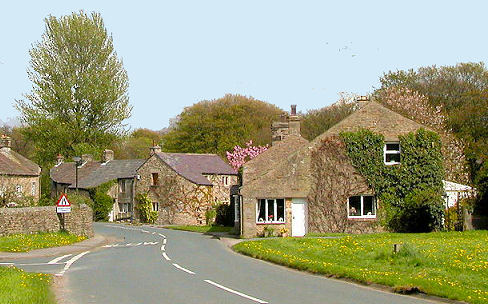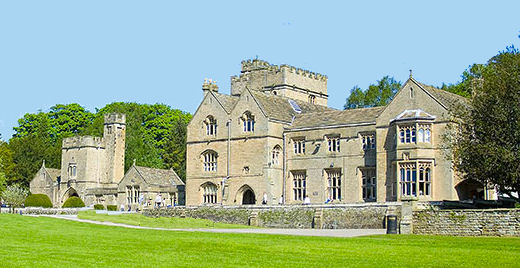Wennington
OS Grid ref:- SD616699
 The attractive village of Wennington lies 11 miles from Lancaster and is situated on the B6480, near the River Wenning, from which it derives its name. The village lies close to Yorkshire's border with Lancashire.
The attractive village of Wennington lies 11 miles from Lancaster and is situated on the B6480, near the River Wenning, from which it derives its name. The village lies close to Yorkshire's border with Lancashire.
The village boasts a long history it is recorded that in 1066 one part of Wennington was held by Ulf together with Melling and Hornby and another part by Chetel with Bentham and other manors. The pleasant village green would in centuries gone by, have been the site of both markets and fairs and an old pound can still be seen near to the River Wenning, where stray animals would have been secured.
The former Punch Bowl Inn, overlooking the village green, has long closed. The narrow bridge over the River Wenning, a Grade II listed structure, marks the boundary of the old Norman Lordship of Lonsdale.
Wennington Hall (pictured below right) , which lies to the north of the village, dates originally from the fourteenth century, but the building the visitor see today is a Victorian Mock Gothic reconstruction, now used as a school.
 Wennington Hall was once the seat of William de Wennington, in the fourteenth century, it passed into the possession of the Morley family. In 1674 the hall was sold to Henry Marsden, who was MP for Clitheroe. It descended to Henry Marsden, who lived at the hall with his younger brother John, known as "Silly Marsden", and their aunt. Henry died in 1780 from alcoholism and John was induced by his guardian aunt and her ambitious husband to sell the hall and purchase Hornby Castle, the hall was bought in 1788 by the Rev Anthony Lister, who took the surname Marsden. The hall was later sold to Richard Saunders in 1841.
Wennington Hall was once the seat of William de Wennington, in the fourteenth century, it passed into the possession of the Morley family. In 1674 the hall was sold to Henry Marsden, who was MP for Clitheroe. It descended to Henry Marsden, who lived at the hall with his younger brother John, known as "Silly Marsden", and their aunt. Henry died in 1780 from alcoholism and John was induced by his guardian aunt and her ambitious husband to sell the hall and purchase Hornby Castle, the hall was bought in 1788 by the Rev Anthony Lister, who took the surname Marsden. The hall was later sold to Richard Saunders in 1841.
The present building occupying the site, designed by Lancaster architect Edward Graham Paley, was constructed in 1855–56 for Richard's son William Allen Francis Saunders, High Sheriff of Lancashire in 1862. After him it passed to Charles Morley Saunders and later William Morley Saunders. During the Second World War it housed the Wennington School, who moved to Ingmanthorpe Hall in Yorkshire at the end of the war. It is now a Lancashire Authority boarding school, Wennington Hall School, which was founded in 1954 for boys with learning or behavioural difficulties.
A walk from Wennington to Wray
Distance- 6 miles
*From the railway station at Wennington exit and turn left onto the road, crossing the railway and continue up the hill. After around 150 metres take the signposted path to your right which path crosses the field to lead onto a tarmac lane. Continue straight ahead up to the farm buildings and turn right through the metal gates and into the field.
*Turn left and head continue too the wood, crossing the hedge via a stile. Enter the wood left of the ruined barns and continue straight ahead across the field, cross the road, pass a house and follow the hedge up to a stile.
*The path then follows a hedge descending the hill and veers slightly to the left away from the fence to a reach stile at the bottom. Cross the stream and ascend the slope. Pass the trees to a signpost ahead by the road.
*On reaching the road, cross over Hindburn Bridge and take the path on the left, which commences at a gate by the bridge. The path goes up a slope across a narrow field and then right, through a wood. After the wood follow the hedge boundary to the road. Turn right and follow the lane down into the village of Wray.
*Retrace your steps to return to Wennington.
Nearby places of interest
The Crook O’ Lune, situated near Caton, a famous beauty spot, where the River Lune meanders in a large curve through tree-lined banks, the view up the valley is superb.
Wray- famous for its Scarecrow Festival,which attracts tens of thousands of visitors each year.
Hornby Castle- once painted by Turner, is an imposing Gothic structure which dominates the landscape from its commanding position above the River Wenning.
Lancaster Castle founded in the tenth century
